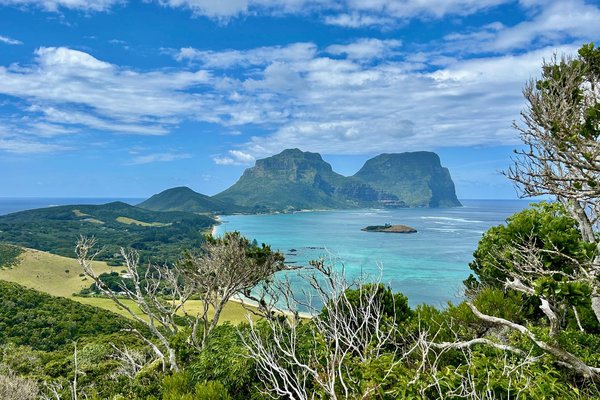Australia
Lord Howe Island
The Lord Howe Island Group represents an island system developed from submarine volcanic activity with a characteristic insular biota.
It consists of islands and rocks that are home to many species of nesting seabirds and other endemic or rare animals. It also features the most southerly coral reef in the world. Besides Lord Howe Island, the designated area includes the Admiralty Group, Mutton Bird and Sail Rock, Blackburn (Rabbit) Island, Gower Island and Ball's Pyramid.
Community Perspective: airfares and accommodation are extremely expensive because of the tourism restriction of 400 beds. Climb the peaks, visit the Lord Howe Island Museum or enjoy its beaches.
Site Info
Official Information
- Full Name
- Lord Howe Island Group (ID: 186)
- Country
- Australia
- Status
-
Inscribed 1982
Site history
History of Lord Howe Island
- 1982: Inscribed
- Inscribed
- Type
- Natural
- Criteria
- vii
- x
Links
- UNESCO
- whc.unesco.org
- Official
-
- lordhoweisland.info — The last paradise
- Related
-
- theguardian.com — Trouble in paradise: Lord Howe Island divided over plan to exterminate rats
- npr.org — Six-Legged Giant Finds Secret Hideaway, Hides For 80 Years
All Links
UNESCO.org
- whc.unesco.org — whc.unesco.org/
Official Website
- lordhoweisland.info — The last paradise
Related Resources
- theguardian.com — Trouble in paradise: Lord Howe Island divided over plan to exterminate rats
- npr.org — Six-Legged Giant Finds Secret Hideaway, Hides For 80 Years
News Article
- May 13, 2025 abc.net.au — Lord Howe Island's famous Kentia palms challenge Darwin's evolutionary theory
- March 16, 2023 abc.net.au — Majority of Lord Howe Island off limits to vistors due to 'highly infectious' plant disease myrtle rust
- Oct. 10, 2022 rnz.co.nz — Student rediscovers 'extinct' cockroach on Lord Howe Island
- April 5, 2019 abc.net.au — Coral bleaching reaches World Heritage-listed Lord Howe Island Marine Park
- Nov. 17, 2017 abc.net.au — Lord Howe tree lobster officially back from dead
- June 14, 2017 abc.net.au — Lord Howe Island's plan for renewable energy rejected over 'visual impact' of wind turbines
- March 24, 2017 sciencedaily.com — A new species of hard coral from the World Heritage-listed Lord Howe Island
- Jan. 14, 2010 heraldsun.com.au — Authorities on Lord Howe are planning an ambitious program to rid the World Heritage-listed site of its rat population
Community Information
- Community Category
- Natural landscape: Insular
Travel Information
Recent Connections
-
Seamount
"The boundary of the property includes …
-
Perfect Inscriptions
1982 -
Centres of Plant Diversity
Au5 Norfolk & Lord Howe Islands - "A si…
Connections of Lord Howe Island
- Geography
-
-
Seamount
"The boundary of the property includes all areas that are essential for maintaining the ecosystems and beauty of the property. It includes all of the above water remains of the ancient shield volcano and surrounding reefs and a substantial proportion of the Lord Howe Island and Balls Pyramid seamounts." (Integrity Statement at UNESCO website Lord Howe page)
-
Pacific Ocean
-
Submerged continent
Zealandia -
Volcanic plugs
"... two mountainous volcanic plugs rising sheer from the sea, Mount Gower (875m) and Mount Lidgbird (777m)"
-
- Ecology
-
-
Critically endangered fauna species
Lord Howe Island Stick-insect (Dryococelus australis) - thought to be extinct on Lord Howe Island itself, but some 30 individuals are surviving on the small islet of Ball's Pyramid (also part of the WHS) (wiki) & Lord Howe Horn-headed Stick-insect (Cornicandovia australica) : possibly extinct. -
Endemic Bird Species
Lord Howe EBA and IBA: 6 speciesSee www.birdlife.org
-
Sea Stacks
Ball's Pyramid -
Lazarus species
Lord Howe Island stick insect: thought to be extinct by 1930 — rediscovered in 2001. -
Notable examples of island gigantism
Giant Stick Insect -
Volcanic Hotspots
Lord Howe Hotspot: "The Lord Howe Rise contains a line of seamounts which formed during the Miozene period when this part of Zealandia existed over the Lord Howe Hotspot"See en.wikipedia.org
-
Penguins
Little (or "Fairy") -
Antarctic Floristic Kingdom
-
Coral
-
- Damaged
- World Heritage Process
-
-
Perfect Inscriptions
1982
-
- Constructions
-
-
Obelisk
McCulloch Obelisk
-
- WHS on Other Lists
-
-
Located in a TCC Territory
Lord Howe Island -
Alliance for Zero Extinction
Nyctophilus howensis (Lord Howe Long-eared Bat) and Gallirallus sylvestris (Lord Howe Woodhen) -
WWF Global 200
Terrestrial, Tropical and Subtropical Moist Broadleaf Forests: (19) Lord Howe-Norfolk Islands Forests; Marine, Tropical Coral: (223) Lord Howe-Norfolk Islands Marine -
Centres of Plant Diversity
Au5 Norfolk & Lord Howe Islands - "A significant number of endemic species or subspecies of plants and animals have evolved in a very limited area. The diversity of landscapes and biota and the high number of threatened and endemic species make these islands an outstanding example of independent evolutionary processes."
-
- Timeline
-
-
Miocene
Lord Howe Island is the highly eroded remains of a 7 million-year-old shield volcano, the product of eruptions that lasted for about a half-million years. (Wiki)
-
- Visiting conditions
-
-
Visitor Limits
400 at any one time
-
- WHS Names
-
-
Named after individual people
Richard Howe, 1st Earl Howe
-
News
- abc.net.au 05/13/2025
- Lord Howe Island's famous Kentia p…
- abc.net.au 03/16/2023
- Majority of Lord Howe Island off l…
- rnz.co.nz 10/10/2022
- Student rediscovers 'extinct' cock…
Community Reviews
Show full reviews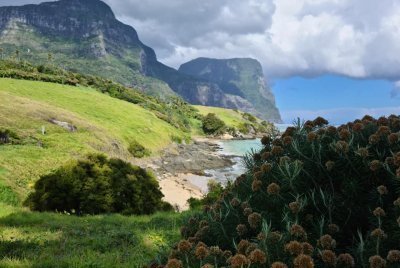
We were lucky with a Lord Howe Island visit in 2021, at the height of the COVID restrictions across Australia as travel was limited and this location and UNESCO site can only receive 400 visitors at a time to ensure that it remains protected and not overwhelmed with visitation. It is an isolated island in the Pacific Ocean off the east coast from the Australian mainland. The natural beauty on the island did not allow me to take a bad picture. On the island is a small township with the main transport being bicycles - get those legs warmed up. There are a number of walking tracks across the Island for you to take in all the island has to offer. Unfortunately, the main walking track to the peak was closed for maintenance during our visit. We also took the opportunity to snorkel around the reef on the island to an array of different fish and turtles. Well worth a visit for the Natural Beauty of the Island.
Keep reading 0 comments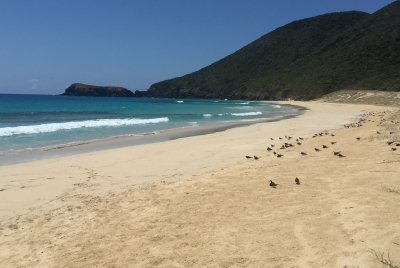
Home to just under 500 permanent residents, Lord Howe is also restricted to just 400 tourist beds, and Quantas has exclusive rights from mainland Australia which makes both airfares and accomodation extremely expensive. Very rarely I have to ask help from the local tourism office, but on Lord Howe this was the case, as I was unable to book a bed, after purchasing the airticket from Sydney. They found Hideaway Guesthouse at 250 AUD a night, just a short walk uphill from that very same tourism office which also houses the island’s museum, and the best internet connection to the outside world. Rent a bike or simply walk around the island, clim the hills to make good photos, and swim in the turquoise and azure blue shades beaches with perfect white sugar beaches like Lagoon or Ned’s. Even the airport is surrounded by the most beautiful beaches, and after checking and the boarding pass in the pockets, I could still enjoy a swim nearby.
Keep reading 0 comments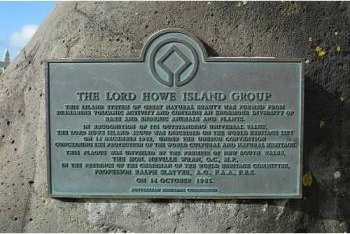
I visited Lord Howe Island in July 2016, when I stayed at Beachcomber Lodge and rented a car from Wilson's Hire Service. My main objective was to see the Lord Howe Island stick insects that are kept at the Lord Howe Island Museum. The stick insects were once very common on Lord Howe Island, but became extinct on the main island soon after black rats were introduced in 1918 when a supply ship ran aground. The last walking stick was observed on Lord Howe Island in 1920, after which time the species was thought to be extinct. In 2001, Australian scientists scaled nearby Ball's Pyramid and discovered a small population of 24 walking sticks living beneath a shrub. In 2003, scientists collected two breeding pairs, and the Royal Melbourne Zoological Gardens has since successfully bred walking sticks (more than 9,000 according to the most recent estimate in 2012). Breeding pairs have since been sent to zoos at San Diego, Toronto and Bristol. I also spent time searching for Lord Howe woodhen, which are now relatively abundant but which had declined to 30 known birds by the late 1970s.
Keep reading 0 comments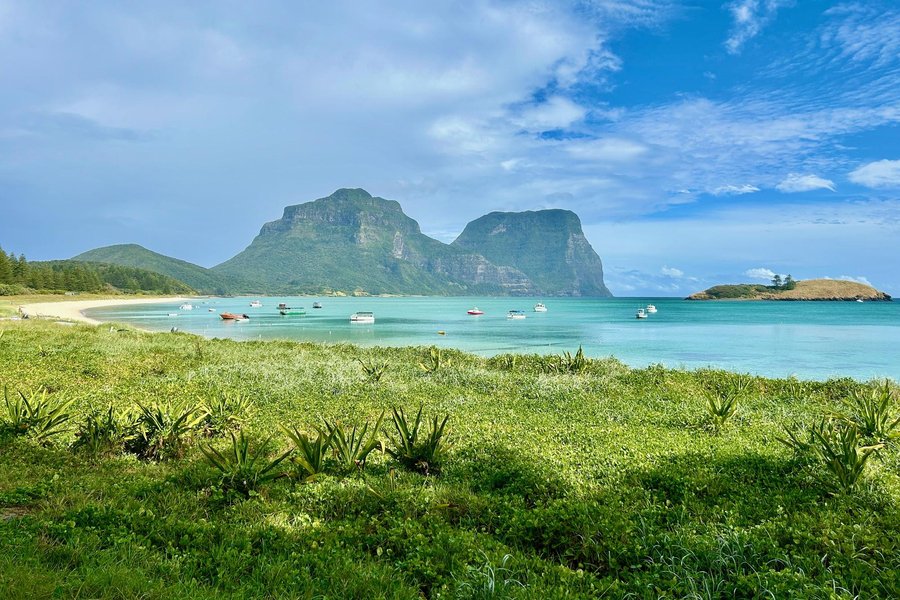
Lord Howe Island is one of the most magical places on Earth.
It has an amazinf natural beauty, the high mountains rising up from the coral encrusted lagoon. The diving is amazing, as the sea life is so prelific.
While not very cheap, due to limits on the number of people it is definately worth the trip out from Sydney.
Keep reading 0 comments
I have been to Lord Howe Island twice, and both times have been a rewarding experiance.
I climbed up Mount Lidgbird on my first visit, but did not get as quite as far as Goat House.
The views you get from anywhere on Lord Howe are spectacular, and you should climb all available mountains and hills.
A camera is a neccesity, so you can capture the lovely scenery when you want to rememer the great time you had, as I did.
I hope to be able to stay there again sometime.
Keep reading 0 comments
